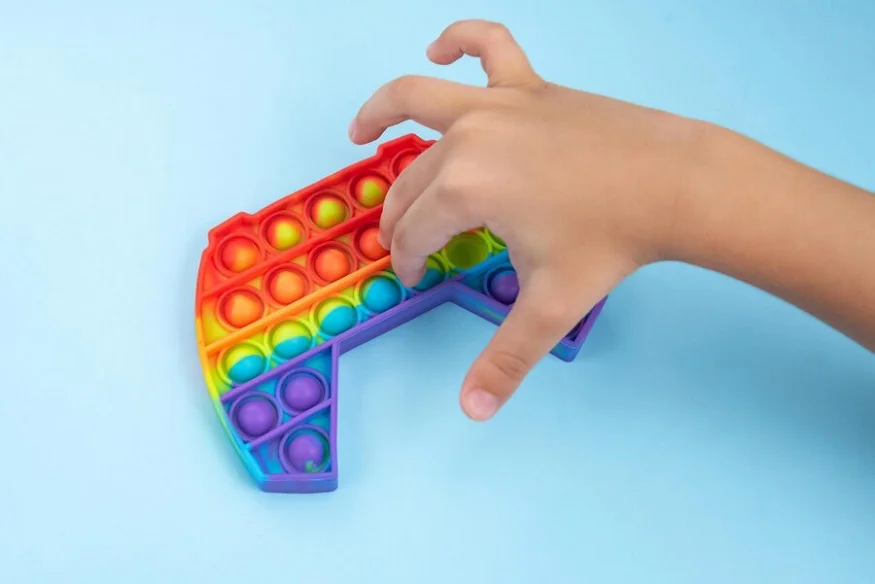Fidget toys have become quite popular over the years, not just as a fun way to pass the time, but also as tools that support learning, development, and even pet well-being. While their use in children’s education is widely recognized, fidget toys can also provide entertainment and stimulation for pets. Let’s take a closer look at how fidget toys benefit both kids and pets!
Fidget Toys in Kids’ Education:
1. Improving Focus and Concentration
Fidget toys, like spinners, cubes, or squishy balls, provide sensory stimulation that helps children with focus, especially those with ADHD or anxiety. By channeling nervous energy into controlled movements, kids can concentrate better during tasks like studying, reading, or completing homework. The rhythmic action of fidgeting can soothe the brain, helping children stay engaged longer.
2. Enhancing Fine Motor Skills
Many fidget toys require fine motor coordination, such as clicking buttons, twisting gears, or pressing textures. This engagement improves dexterity and hand-eye coordination, which is vital for developing skills in writing, drawing, and other activities that require precision.
3. Stress Relief and Emotional Regulation
Children often experience stress or frustration when faced with challenging tasks, social situations, or changes in routine. Fidget toys offer a tactile outlet for these emotions. By engaging with a fidget toy, kids can self-regulate their emotions, reducing feelings of anxiety or agitation, and returning to their activities with a calm and focused mind.
4. Sensory Learning Opportunities
Fidget toys come in a variety of textures, shapes, and sizes. This diversity offers a sensory learning opportunity for younger children. By exploring different textures, such as soft, bumpy, or rubbery surfaces, kids can develop a better understanding of tactile feedback and sensory input, which is especially beneficial for children with sensory processing challenges.
5. Boosting Creativity and Problem-Solving
Fidget toys that include puzzles or interactive elements can also spark creativity. For example, fidget cubes with different switches, gears, or dials encourage problem-solving skills. Kids may find themselves experimenting with new ways to interact with their toy, fostering critical thinking and innovative approaches to challenges.
Fidget Toys for Pets: Engaging Play and Mental Stimulation
It’s not just kids who benefit from the calming and stimulating effects of fidget toys—pets, particularly dogs and cats, can also enjoy them. Pet fidget toys are designed to keep animals active, mentally sharp, and entertained. Here’s how they work:
1. Reducing Anxiety and Stress in Pets
Similar to how children use fidget toys to calm their nerves, pets can also benefit from stress-relieving toys. Dogs and cats may use interactive toys like chew balls, puzzle feeders, or treat-dispensing gadgets to keep themselves engaged and reduce anxiety, especially during stressful situations such as being left alone or during thunderstorms.
2. Promoting Physical Exercise
Fidget toys for pets are often designed to encourage movement. Toys like rubber balls, squeaky toys, or tug ropes can help dogs stay active, which is important for their physical health. Cats, too, enjoy interactive toys such as laser pointers, feather wands, or balls that they can bat around. By engaging with these toys, pets get a fun and stimulating workout.
3. Mental Stimulation and Problem-Solving
Puzzle toys designed for pets can boost their mental acuity. Dogs and cats can work out how to access hidden treats or solve simple challenges, keeping their minds sharp. These toys are not just a source of entertainment; they encourage problem-solving, which can help prevent boredom and unwanted behaviors caused by a lack of mental stimulation.
4. Teething and Chewing Relief
For puppies and kittens going through the teething phase, fidget toys made from soft, durable rubber can soothe sore gums and provide an outlet for their chewing instincts. Not only does this keep them entertained, but it also prevents them from chewing on furniture or other items they shouldn’t.
5. Building Bond Between Pet and Owner
Interactive fidget toys, like tug-of-war ropes or fetch balls, are also great for strengthening the bond between pets and their owners. These toys promote cooperative play and can be used to train pets, reinforcing positive behaviors and creating a stronger connection.
Conclusion: Fidget Toys for Learning, Play, and Well-Being
Whether it’s helping kids stay focused during school or providing pets with mental and physical stimulation, fidget toys are versatile tools that serve a variety of important functions. For children, these toys promote emotional regulation, concentration, and fine motor skills, while for pets, they offer entertainment, stress relief, and mental stimulation. In a world filled with distractions and stresses, fidget toys provide a simple, effective solution for keeping both kids and pets calm, engaged, and happy.

